Mosaic Art 2 Fish and 4 Loaves of Bread
A mosaic depicting fish, birds and baskets of what may exist staff of life, newly uncovered most the Ocean of Galilee, may commemorate the historic location of the miracle recorded in the New Attestation in which Jesus miraculously feeds a multitude, according to the atomic number 82 archaeologist at the site, Haifa University'southward Dr. Michael Eisenberg.
The colorful mosaic was uncovered in the ongoing Hippos-Sussita Excavation Project at the Sussita National Park's Southward-Westward or Burnt Church building. The 15-meter by 10-meter mosaic carpeting is bursting with fish, birds and 12 baskets filled with fruit, flowers and — arguably — breadstuff. The traditional location of the miracle is across the body of water at the Church of the Multiplication of the Loaves and Fish in Tabgha, which houses a famous mosaic depicting two fish on either side of what is thought to be a bread basket.
Information technology is the Sussita church'south combination of fish and bread baskets that has led Eisenberg to believe that the mosaic could exist a record of the miracle of the multiplication of the loaves and fishes and a clue hinting at a historic location for the feat.
In conversation with The Times of Israel on Wednesday, Eisenberg said that this miracle, equally well equally a multitude of Jesus'south other miracles, occurred nether the directly gaze of the church — located nigh the shores of the Ocean of Galilee. He believes that they are all symbolically depicted in the mosaic.
"The symbolism behind [the mosaic] and the position of the church in the perfect place, overlooking Sea of Galilee where most of his miracles took place, means I'm rather sure that the people recognized and interacted with the geographic, physical places where the miracles occurred," he said.
Depicted in the mosaic, said Eisenberg, are fish, two of which occupy an important "heraldic" position in the church building apse, besides as 12 baskets, some of which are filled with pomegranates and probably one with apples and flowers. Other baskets, he said, more directly harken to the well-known phenomenon and are filled with round loaves of staff of life: one with five loaves, ane or two with seven loaves, and 2 with six loaves, he said.
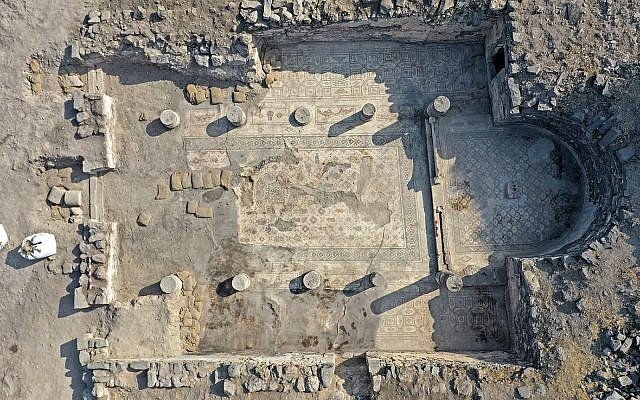
The mosaic at the 'Burnt Church' at the Hippos-Sussita Excavation Project at the Susita National Park, summer 2019. (courtesy)
Equally reported by The Times of State of israel in July, the Burnt Church building was constructed in two phases, in the second one-half of the 5th and 6th centuries, said Eisenberg, and the mosaics — including at least three inscriptions — are probable from the 6th century. The archaeologist hypothesizes that information technology was razed during the Persian Sassanian conquest of the state in the early seventh century. None of the other 6 churches excavated at the site evidence such destruction.
Ane of the unique aspects of the Burnt Church'south mosaic, he said, is that it is "very simple, naive, even charming in its nascence. Information technology was ordered by the local people, which is why at that place are more than interesting depictions," he said. Another xx per centum of the mosaic is yet to be excavated.

Potential staff of life handbasket from a mosaic at the 'Burnt Church' at the Hippos-Sussita Excavation Project at the Susita National Park, summer 2019. (courtesy Michael Eisenberg)
The miracle of the loaves and fishes actually appears in two New Testament stories, said Galilee-based priest Dr. Francesco Giosuè Voltaggio, who holds a PhD in archaeology. Jesus did two split multiplications of loaves and fishes, both forth the Sea of Galilee.
"Co-ordinate the Gospel and the former Christian tradition there are 2 multiplications and two places," said Voltaggio. A passage in Mark 8:xvi-21 refers to ii loaves and fishes miracles in one dialogue.
The first involved five loaves and two fish that became enough nutrient for some 5,000 Jewish men (women and children were non counted) on 1 side of the Ocean of Galilee. Its location is traditionally placed at Tabgha. The other, said Voltaggio, was conducted for some four,000 infidel men and occurred on the side of the lake. That phenomenon, chronicled in Mark and Matthew, involves vii loaves of bread and "a few minor fish."
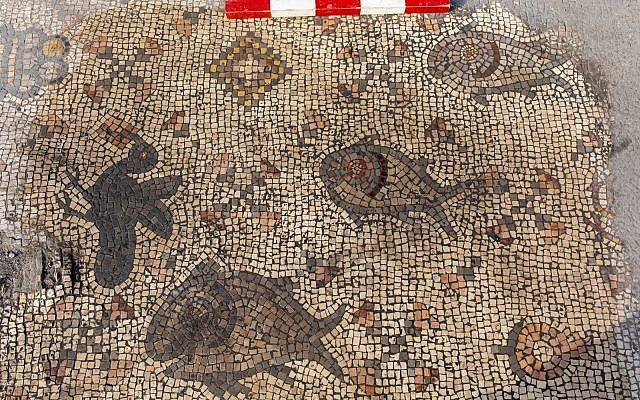
Item from a mosaic at the 'Burnt Church' at the Hippos-Sussita Excavation Project at the Sussita National Park, summer 2019. (courtesy)
In the first multiplication for Jews, said Voltaggio, the apostles took away 12 baskets of loaves (for the 12 tribes); in the second one, there was enough leftover nutrient to fill seven baskets. The numbers 7 or seventy are symbols for not-Jews, he said.
"The pilgrims go along the memory of this 2d miracle in Tel Hadar," Voltaggio explained, which is about ten kilometers n of the location of aboriginal Hippos/Sussita where the Burnt Church mosaic is plant.
Archaeologist Eisenberg acknowledged that the first phenomenon is traditionally tied to Tabgha on the west side of the sea, simply he suggested that a careful reading of the text tells a different story. "Jesus walked on the bounding main towards Tabgha afterwards the miracle of the loaves and fishes: How could the miracle take happened there?" he asked.
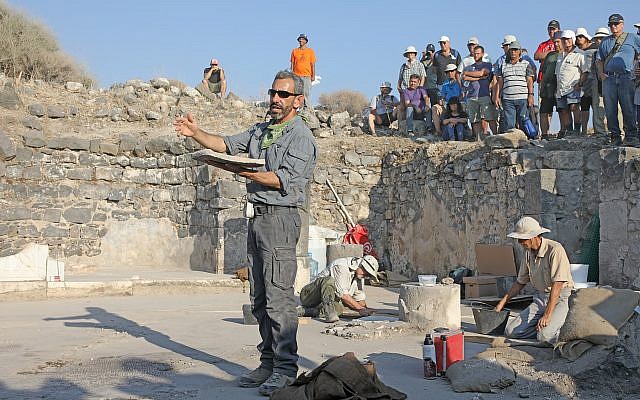
Archeologist Dr. Michael Eisenberg, dig director of the Hippos-Sussita Excavation Project, at the Sussita National Park, summer 2019. (courtesy)
Eisenberg hypothesized that it could have happened on the northern edge of Hippos domain, what the Romans chosen the Hippos Territorium, which stretched from the southern part of the Sea of Galilee, and nearly reaching the northern corner, northward of Kursi, which is very shut to Tel Hadar. "I remember the miracle happened there," said Eisenberg.
Although the miracle is recorded in two of the four books of the gospels, there are those that don't believe the 2d miracle historically occurred.
"For some scholars, the 2d multiplication is a merely symbolic duplication," said Voltaggio, who heads a seminary in the Galilee. The new discovery, he said, "reevaluates the historicity of the two miracles," which according to the gospels occurred on both sides of the Sea of Galilee.
"The 2 locations, Tabgha and Sussita are not opposed," emphasized Voltaggio.
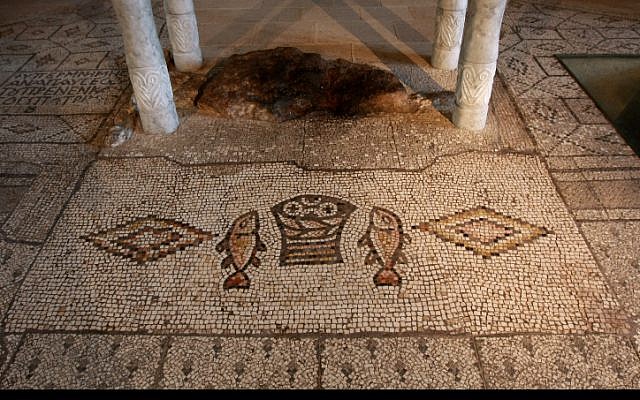
Mosaics preserved from the Byzantine catamenia at the Church of the Multiplication of the Loaves and the Fishes at Tabgha, on the Body of water of Galilee. (Rishwanth Jayapaul/FLASH90)
Not everyone agrees with Eisenberg'due south identification of the bread baskets, however. Archeologist Dr. Anat Avital, an practiced in mosaics of the Byzantine period who is not connected to the Sussita excavation, does not support Eisenberg'south position.
After studying thousands of mosaics in the region and parts of Europe and North Africa, she firmly suggested that the so-called bread loaves are in fact fruit.
"It could only be fruit, on the size calibration of apples. I accept seen many other mosaics with almost exactly the same baskets, which usually contain fruit, sometimes flowers," she told The Times of Israel.
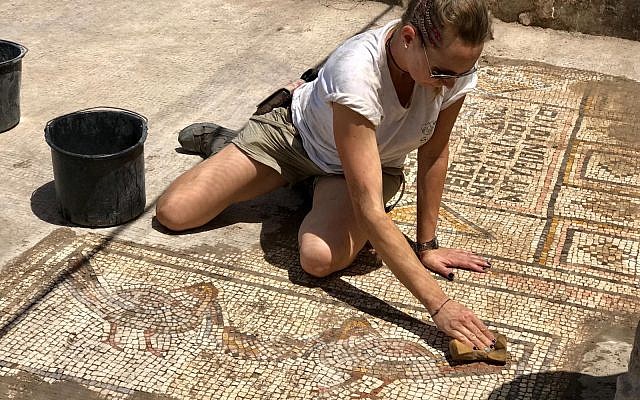
Conservation manager Yana Vitkalov cleans a mosaic at the 'Burnt Church' at the Hippos-Sussita Earthworks Project at the Sussita National Park, summertime 2019. (courtesy)
"Another great sign and clue that the creative person meant to show fruit is that you can see a pruning tool depicted beside ane of the baskets," said Avital. The artists, she said, "desire to tell us that we took this small curved knife for the picking of the fruit."
The only other known location with a depiction of a handbasket of loaves is Tabgha, simply while she would non touch a traditional reading, also there she is not entirely convinced.
Similar other mosaics in State of israel and Hashemite kingdom of jordan, she said, the carpet is meant to be taken very literally and show that "if you come to the church building, believe in God and you will have very good fruits to eat," she said. The mosaic's delineation of compensation is "symbolic of one of the most fundamental things in our lives, we need to eat," she said.
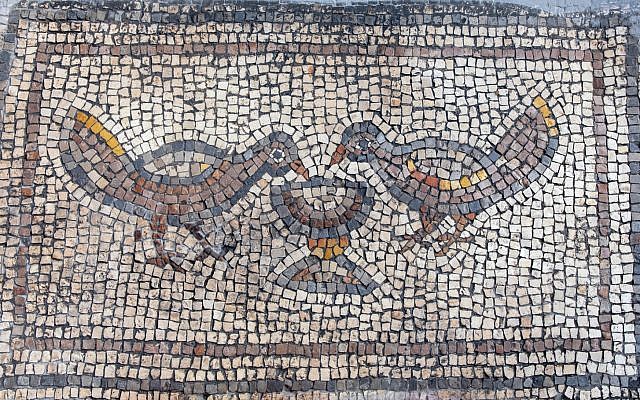
Detail from a mosaic at the 'Burnt Church' at the Hippos-Sussita Excavation Project at the Sussita National Park, summer 2019. (courtesy)
In the Byzantine era, she said, information technology is rare to find symbolic fine art in churches. Rather artists "show terrestrial living, the about firsthand things you demand — air, water, nutrient and protection against enemies/beasts, etc."
Likewise, at that place is goose egg significant in the number of baskets or medallions in the mosaic, said Avital and adding layers of meaning is an a-historic anachronism. "We must sympathise that the people were illiterate, about of them." Mosaics depicted themes "in a way that is like shooting fish in a barrel to understand, not in clues, not like today," she said.
Avital qualified that until the mosaic creative person rises from the grave, nosotros'll never really know his intentions, just she hypothesized that when the last 20% of the mosaic is uncovered, the squad will likely come across something else.
Pb archeologist Eisenberg praised and welcomed the "good for you debate." "Where is exactly the line between organized religion, decoration and symbolism?" he asked. He said the team will continue to talk over the mosaic's significant.
"We have enough miracles for everybody," laughed Eisenberg.
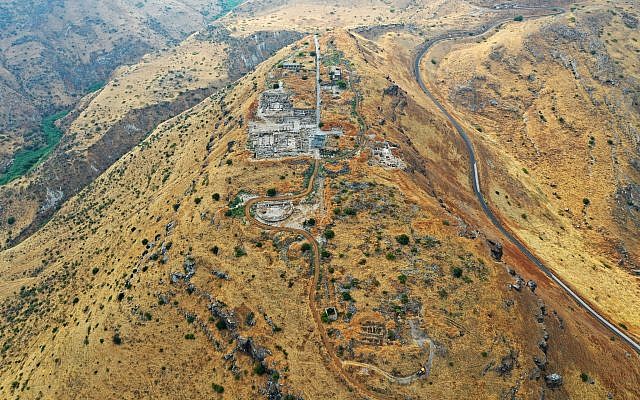
Aerial view of the Hippos-Sussita Excavation Projection at the Sussita National Park, summertime 2019. (courtesy)
Source: https://www.timesofisrael.com/mosaic-near-sea-of-galilee-may-mark-new-site-for-jesus-loaves-and-fishes-miracle/
0 Response to "Mosaic Art 2 Fish and 4 Loaves of Bread"
Post a Comment